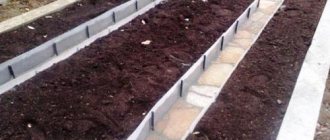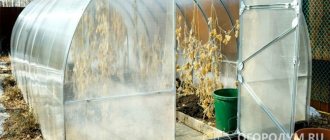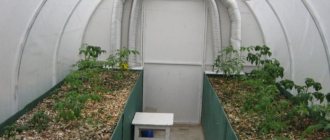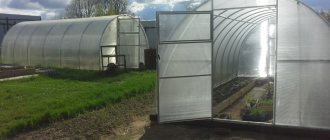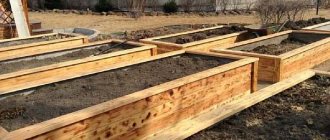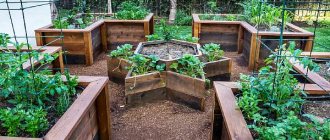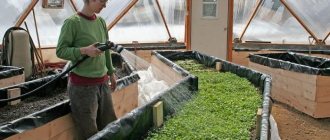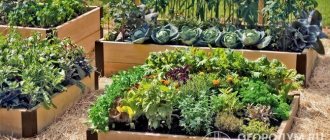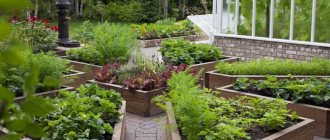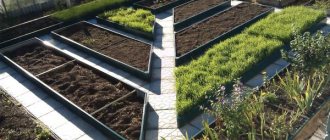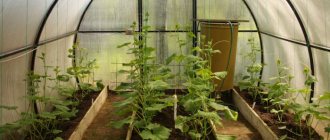Experienced gardeners are well aware that it is necessary not only to install the greenhouse correctly, but also to correctly plan the location of the beds in such a greenhouse. We will tell you in more detail about how to make beds in a polycarbonate greenhouse, which will allow you to get an excellent harvest.
When planning the location of beds inside a greenhouse, it is necessary not only to take into account the size of such a greenhouse, but also its orientation to the cardinal points , the requirements of the crops grown, the terrain, as well as a number of other factors. This is the only way you can get an excellent harvest, significantly simplifying the care of your plantings.
We make beds in a greenhouse 3 by 4 meters
Standard rectangular polycarbonate greenhouses, which measure 3 by 6 meters, are very popular today. Such designs are both universal and allow the greenhouse area to be used with maximum efficiency.
In greenhouses measuring 3 by 6 meters, beds can be arranged as follows:
- Plantings are planted along the walls, and a wide passage is left in the center of the greenhouse.
- Set up two narrow areas for planting near the walls and one wide one in the center. Such a greenhouse will have two passages 20 centimeters wide, and the beds can measure 40 centimeters on the sides and about 100 centimeters in the center.
- Two wide passages and three narrow beds are made.
Advice. If you have three rows of plantings in the greenhouse, then it is best to make the central one the widest, which will significantly simplify the care of the plantings.
Passages should not be made less than 60 centimeters wide. Such savings can lead to a significant complication of caring for plantings, so using such a greenhouse will not be very convenient.
Description of some greenhouse models
There are a large number of different models of 3x4 greenhouses on sale. Let's look at some of them.
Greenhouse "Stolichnaya"
This model has gained recognition among all summer residents and gardeners due to its reliable frame. The base is made of durable galvanized steel pipe. The structure consists of interconnected arc trusses. The manufacturer claims that this device is designed for snow loads of up to 200 kg.
The Stolichnaya greenhouse is distinguished by a durable frame Source irr.ru
See also: Catalog of companies that specialize in the installation of metal structures.
Among the main characteristics, it is worth noting thick - 4 mm polycarbonate, two doors and two windows. The model was developed specifically for the northern regions of Russia.
The 3x4 greenhouse kit includes the following parts:
- Two ends.
- Five arched arcs.
- Eighteen ties 0.65 m long.
- Four bases for the bottom.
- Basic fittings.
- Passport and warranty for the Stolichnaya greenhouse.
If you purchased such a 3-meter greenhouse and then realized that there is still enough space, then you can purchase additional arches and polycarbonate and increase the length of the structure.
Greenhouse "Kremlevskaya"
The main feature of the design is that the frame consists of a double galvanized pipe with a cross-section of 25x25 mm. The arc pitch is 1 m. There are two vents at the ends of the greenhouse.
In general, the Kremlevskaya greenhouse is a high-quality and reliable structure that has received recognition among gardeners. Interestingly, it is these greenhouses that can tolerate freezing rain. In addition, this greenhouse is very resistant to corrosion, because the frame is coated with a powder composition. Joints and seams are treated with particular care.
The frame of the Kremlyovskaya greenhouse is protected from literally everything Source fermer.blog
It is recommended to install such greenhouses on a timber foundation. If this is not possible, then lugs should be used. Among the possible improvements, it is worth noting sections for increasing the length and additional windows in the side walls. All this can be bought at almost any gardening store.
We take into account the cardinal directions when planning beds
The gardener needs to take care of the correct location of the greenhouse even before installing it . Remember that most crops grown in greenhouses are light-sensitive, so it is necessary to position such a structure in such a way that it is illuminated by the sun to the maximum. All plants in the greenhouse should receive the maximum amount of sunlight possible. In the future, this will have a positive effect on productivity indicators.
There are two ways to arrange the beds in a greenhouse relative to the cardinal directions:
- From North to South.
- From west to east.
Moreover, the first option is recommended when growing tall crops that can receive maximum sunlight. But if you plan to grow low-growing varieties of vegetables and fruits in a greenhouse, then it is best to orient the greenhouse from north to south.
Thermal cushion made from scrap materials
A very simple, but also effective technology for soil insulation is to place natural materials at the bottom of the box that can release heat as a result of decomposition. Fallen leaves, straw, hay, and freshly cut grass will be used. You can also add potato peelings, sawdust, chopped branches and unnecessary paper there. All this is compacted and covered with fertile soil.
Warm bed based on leaves
In a business like growing plants, everything matters. A good harvest can only be obtained if all the necessary factors are taken into account and the sprouts are provided with everything they need.
We carry out the greenhouse according to Mitlider
The technology of growing crops using the Jacob Mittleider method . The use of such agricultural technology not only increases yields, but also simplifies the care of plantings. When using this technology for growing crops, it is necessary to take into account the following features of the location of the beds:
Plantings should be oriented from north to south.
The optimal width of the beds is 45 centimeters.
Planting is carried out in two rows, which will allow the plants to receive maximum sunlight and ensure their high-quality ventilation.
- The passage is made at least 90 centimeters wide.
- The soil surface in the greenhouse is perfectly flat, which is necessary for uniform distribution of fertilizers and water.
- Along the edges there are earthen sides 10 centimeters high.
- It is necessary to consider methods of applying fertilizers and an irrigation system.
Principles for creating high warm beds
In recent years, the technology of arranging high warm beds , which make it possible to grow various vegetables and fruits in greenhouses almost all year round, has become very popular. Setting up such a greenhouse is not particularly difficult, so we can recommend such agricultural technology even to novice gardeners.
Low beds raised to a height of about 10 centimeters are an excellent option for fertile soils that have low groundwater levels. The only drawback of such raised low beds is that it will be difficult to use fertile soil mixture in this case.
Raised beds to a height of 30 centimeters will be an excellent option for marshy soils and soil poor in microelements. We can recommend similar options for arranging beds for crops that have a superficial root system . So, in particular, you can grow various cucumbers in a similar way, using nutritious fertile soil when planting.
High beds are made using special plastic or wooden sides; you can also use moisture-resistant plywood. This option will be an excellent solution for poor and waterlogged soils. Thanks to this height, various root crops can be grown in the greenhouse, while obtaining an excellent harvest. Such soil will warm up quickly, and subsequently will be able to retain heat for a long time, and crops grown in the greenhouse will bear fruit early, and the gardener will be able to reap the harvest right up to the frost.
Thermal cushion made of wood
When decomposing, any organic material, like manure, will produce heat, albeit not as intensely. So if you have nowhere to get organic matter, you can use leftover wood materials. Shredded wood waste and materials are placed at the bottom of the box. To compact the bottom layer, you can fill the gaps that will inevitably remain with food waste, grass, young (without seeds) weeds, tops, etc. All this is sprinkled with a mixture of sand and peat and filled with either boiling water, or diluted bird droppings or urea to speed up the start of the process . In order to enhance the decomposition of plant waste, you can use special preparations. They contribute to the rapid decomposition of the material and the formation of humus.
Sawdust can be used to create a warm bed
Important! Birch wood has disinfecting properties, so using this material as a thermal cushion (at least partially) will bring double benefits.
The compacted layer is covered with regular or black plastic film for a week, and only after that it is covered with a layer of soil of about 30 cm. The thermal layer of wood will last for several years until the material completely decomposes.
Galvanized beds for greenhouse
Farming technologies today do not stand still. Beds made from various available materials are very popular in polycarbonate greenhouses. We can recommend that you use galvanized metal , which has excellent performance characteristics. This material is affordable and easy to use. If we talk about the advantages of such galvanized beds for greenhouses, we can note the following:
- Excellent durability.
- Ecological cleanliness.
- Resistance to high temperatures and high humidity.
- Aesthetic appeal.
- Possibility of easy assembly and disassembly.
- Galvanized materials are not susceptible to mold and mildew.
Making your own gutters from galvanized profiles is not difficult. You only need to use corners, screws for fastening and the profile itself . Subsequently, the completed containers are filled with earth, into which the seedlings are planted.
The use of such beds, made of galvanized profiles, can significantly simplify the care and harvesting, while the gardener uses the available greenhouse area with maximum efficiency.
The most “favorite” mistakes of summer residents
According to tradition, we’ll start by analyzing other people’s mistakes in the planning and arrangement of protected ground, so as not to repeat them ourselves.
- “I want everything at once!” Becoming the happy owners of a greenhouse, summer residents try to make the most of the usable space. They plant literally every centimeter, counting on a great harvest. And in the end they remain disappointed. Firstly, every crop requires sufficient space for its leaves, shoots and roots. But where can it grow if another plant is already sitting nearby, also trying to win a piece for itself?! The result is a real jungle, where the more active inhabitants oppress the shorter ones, and the paths are hidden under a carpet of vegetation. Secondly, for high-quality pollination and growth, access to air and light is required, but this is impossible in thickets. Thirdly, diseases and pests simply adore the “jungle”, where all the conditions for their development are created. So summer residents are running around with sprayers, receiving cocktails of fungicides and insecticides instead of organic vegetables.
- "Let's marry the fox and the hen." Inexperienced gardeners try to combine a variety of crops in one greenhouse, without taking into account their needs for microclimate, lighting and soil. The most typical example is tomatoes and cucumbers. Cucumbers require warmth and humid air, and tomatoes begin to get sick from humidity, becoming covered with late blight. Even greenhouse manufacturers make combined options, separating them with a partition.
- “We plant as is.” Often, after installing a polycarbonate structure, the owners simply dig up the soil inside and plant plants, wondering later why they don’t grow and get sick. The point is the most banal physical laws: while the “tops” warm up in closed ground, the roots freeze in the ground, because the cold from outside is directly transferred inside, under the shelter. As a result, the leaves are hot, want to drink and eat, but at this time it is winter at the roots - they have trouble absorbing cold water. And somewhere on the border a conflict occurs, leading to the death of the poor plant.
- “Wider and bigger.” Another common mistake is to take up as much space as possible with beds, leaving a minimum for walkways. As a result, it is inconvenient to weed wide ridges, you can’t reach the plants, and you can’t even walk along narrow paths with a watering can, let alone with a wheelbarrow.
- “They made it out of what was there.” Some summer residents believe that the beds in the greenhouse can be fenced off with whatever is necessary, as long as the soil does not spill into the passages. In particular, the worst option is boards. Considering the constant “tropics” of protected soil, even thoroughly impregnated wood is not enough for five years. Rot and mold, moisture and fungus quickly destroy borders, then crawling onto plants.
Here is a kind of TOP 5 typical mistakes of beginners who are learning vegetable growing in protected ground for the first time. All of them lead to a natural result - disease and death of plants, low yields and dissatisfaction, complete with irritation among the owners themselves.
We use the greenhouse area with maximum efficiency
The natural desire of every gardener is to obtain the maximum possible yield from the available garden area. To increase the useful volume of the greenhouse, you can place the beds vertically, for which you use hanging pots, shelving, or practice vertical planting. Using such agricultural technology, you can grow various annual plants that have a small root system. Such a garden greenhouse with vertical plantings will be an excellent option for growing radishes, strawberries, lettuce, onions and various herbs.
are installed inside the greenhouse , in which sides are arranged or plantings are placed in pots. We can only recommend that you do not make such racks too wide, which can complicate the care of the plantings and impair the lighting of the crops located on the lower tiers.
Hanging pots can be used for growing peas, beans, strawberries, and various hanging plants. It is only necessary to provide high-quality watering to the plantings and regularly ventilate the greenhouse, which will maintain the temperature and humidity conditions at the optimal level.
To arrange vertical plantings, cut pipes, metal gutters, all kinds of pots and plastic bottles can be used. In this case, the gardener will need to think about how to properly water such vertical beds in a greenhouse.
What should the height of the bed be?
When the location of the beds in the greenhouse has already been planned, they begin to equip them. To do this, install a board made of boards, slate, metal or polycarbonate, and then pour the substrate into the resulting boxes. The standard height of the ridge is 20 cm. But the higher the boxes, the warmer the soil in them will be. To obtain early greens and vegetables, it is recommended to make a box 80 cm high. Moderately warm soil will promote rapid plant growth and early fruiting. There are several ways to arrange additional heating of the soil.
Tall boxes for arranging beds in a greenhouse
Advice! In tall boxes, the soil loses moisture faster, so it is necessary to regularly moisten the soil to prevent the plant roots from drying out.
